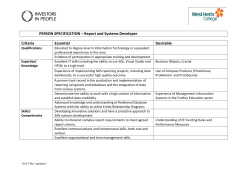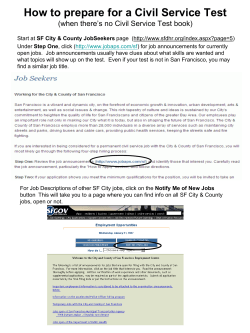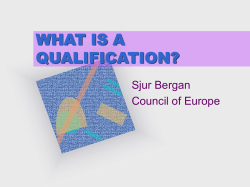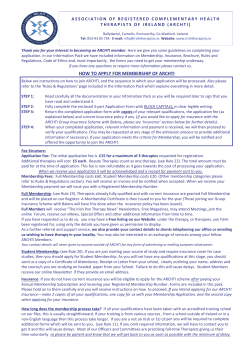
Implementation of the Roadmap for TVE reform Dr. Vladimir Gasskov
Implementation of the Roadmap for TVE reform Dr. Vladimir Gasskov for the Project «Development of Strategic Directions for Education Reforms in Kazakhstan 2015-2020» (vgasskov@gmail.com) Astana June 2014 The milestones for development of the roadmap for TVE reform (2015-2020) • Findings on the situation in the TVE system and processes and related problems in Kazakhstan were presented in June 2013 and discussed with the MoES • A draft Roadmap for TVE reform presented in 2013 • The Roadmap proposal was utilized by the TVE Department, MoES in the development of their reform proposal • There is a broad similarity of opinions between the project team and the MoES on the principle directions and activities for the TVE reform in the country for 2015-2020 2 Architecture of the Roadmap for the TVE reform in Kazakhstan, 2015-2020 (proposal by the project team) The National Vision Statement for education: “By 2020, Kazakhstan will have become an educated country with smart economy and highly qualified labour force” Strategic Priority Areas for the Education Reform in Kazakhstan Strategic Priority Area I: Selected components of the Human Strategic Priority Area II: Occupational and qualification structures Development Index improved of the labour force (in comparison with that of EC or OECD countries) improved Strategic Objectives Strategic Objective 1: To ensure equal Strategic Objective 2: To introduce a system Strategic Objective 3: To improve access of various consumer groups to TVE of quality assurance and quality improvement effectiveness of governance and and improve its relevance to the labour in TVE management of TVE market demand Strategic Outcomes Outcome 1.1: National educational policy Outcome 2.1: A national policy of TVE Outcome 3.1: National TVE policy and legislation promote equal access of quality assurance and improvement is development and steering process various consumer groups to TVE developed established with broad stakeholder Outcome 1.2: TVE system has developed a Outcome 2.2: National qualifications system participation capacity for identification of learning and is improved and administered by a dedicated Outcome 3.2: TVE system has developed a employment needs of various consumers national agency capacity for evidence-based decision making groups Outcome 2.3: National system for quality Outcome 3.3: The appropriate forms of Outcome 1.3: TVE system has developed a assurance of TVE institutions is established public-private partnerships in TVE identified capacity for responding to the learning and Outcome 2.4: National standards and and supported employment needs of various consumers procedures for developing the quality-assured Outcome 3.4: The appropriate model of the groups TVE programs introduced “cooperative learning system” developed Outcome 1.4: TVE system has developed a Outcome 2.5: The quality-assured assessment and introduced taking account of employers’ capacity for identification of the labour of learning outcomes is introduced and students’ interests market demand for the competent workforce Outcome 2.6: A national system for Outcome 3.5: A collegial governance and and for responding to this demand adequately preparation of TVE teaching personnel is management is introduced in public TVE Outcome 1.5: A national TVE financing improved institutions system supports the equality in TVE across Outcome 2.7: TVE funding mechanism Outcome 3.6: Funding mechanism provides regions, rural/urban areas, consumer groups, ensures that institutions receive adequate support for the access, equity, quality, and individuals funding for delivering quality education efficiency, and excellence in education programs 3 Strategic Objective 2: To introduce a system of quality assurance and quality improvement in TVE (from the proposal by the project team) • Outcome 2.1: A national policy of TVE quality assurance and improvement is developed • Outcome 2.2: National qualifications system is improved and administered by a dedicated national agency • Outcome 2.3: National system for quality assurance of TVE institutions is established • Outcome 2.4: National standards and procedures for developing the qualityassured TVE programs introduced • Outcome 2.5: The quality-assured assessment of learning outcomes is introduced • Outcome 2.6: A national system for preparation of TVE teaching personnel is improved • Outcome 2.7: TVE funding mechanism ensures that institutions receive adequate funding for delivering quality education programs 4 Plan of the reform proposed by the MoES involves the Objective: «Development of the quality system for TVE» III.1. Improvement and introduction of the national system of qualifications 1.Analysis of the qualifications system adopted in Kazakhstan and its improvement taking account of the international experience 2.Organization of development and approval of occupational standards for economic sectors III.2 Development of a proposal for setting-up a national qualifications authority for TVE sector III.3 Analysis and improvement of procedures of registration and accreditation of TVE providers III.4 Review and improvement of the learning content of TVE programmes III.5 Development of a proposal for independent assessment and certification of TVE graduates 5 Project support for implementation of the TVE reform in Kazakhstan in 2014 • Report of the international practice on: National Qualifications Frameworks and their application to the development of standards-based qualifications (review of NQFs and of the methodologies for development of occupational standards and qualifications in Australia, UK, and France) • Report of the international practice on: National Qualifications Authorities for TVE and HE: Alternative Concepts, Structures, Functions, and Procedures (based on experiences of Australia and UK) Reports will be produced with participation of international experts from the countries under review 6 The purpose of National Qualifications Frameworks • NQF is an instrument for the development and classification of qualifications, their comparability and their recognition; it supports progression between NQF levels and across qualifications and occupations • NQFs are based on structured descriptions of outcomes of learning (qualifications), but not on descriptions of learning programmes; • Countries which adopt NQFs make a commitment to put greater emphasis on the outcomes of learning and recognize that the same learning outcomes may be achieved through many learning avenues • NQFs have level descriptors which are defined by learning outcomes (statements of what the learner must know, should be able to do, and apply in defined work contexts) • The major feature of NQFs is that they contain national Qualification Types, describe their specifications, and show their place on NQF levels • NQFs describe policies and regulations regarding the development and recognition of national qualifications (based on NQF qualification types) • NQFs are expected to prescribe whether or not national qualifications should be based on occupational standards, etc. 7 TVE qualifications in Australia placed on NQF levels NQF Qualificati Purpose Level on Type 6 5 4 3 2 1 Advanced Diploma Diploma Certificate IV Certificate III Certificate II Certificate I Senior Secondary Certificate of Education Certificate IV qualifies individuals who apply a broad range of specialised knowledge and skills in varied contexts to undertake skilled work and as a pathway for further learning Knowledge Skills Application of knowledge and skills Volume of learning Graduates of Certificate IV will have broad factual, technical knowledge in a specialised field of work and learning Graduates of Certificate IV will have: -skills to analyse, compare and act on information from a range of sources -technical and communication skills to apply technical solutions Graduates of Certificate IV will apply knowledge and skills to: -tasks and functions in known or changing contexts -with responsibility for own functions and outputs - with limited responsibility for output of others The volume of learning of up to 2 years 8 NQF level descriptors in Kazakhstan (matched to the European Qualifications Framework) Qualification Level Knowledge Skills 1 No National Qualification Types - The way -Skills for routineknowledge has non-routine tasks, been acquired? -Skills for creative decisions, etc. Personal and professional competence -Autonomy -Responsibility for self and for work of others 2 3 4 5 6 7 8 9 National Qualifications Framework (NQF) in Kazakhstan • NQF in Kazakhstan does have descriptors of its levels (although the descriptors for «knowledge requirements» need to be reviewed) • NQF does not have QUALIFICATIONS TYPES; it remains unclear which qualification types correspond to which NQF levels • In order to place qualification types on NQF levels, it is necessary to develop specifications for qualification types • In terms of national qualifications, NQF claims that it is coherent with the Republican Education Law; however the Education Law does not determine educational qualifications and their specifications (it describes a variety of education programmes) • NQF in Kazakhstan has 8 levels (matched to the EQF levels); this means that at least 4 upper levels are supposed to be assigned to the generic qualification types - Doctors, Masters/Graduates, Bachelors, and Technicians. Therefore only 4 NQF levels are left for workers’ qualifications • However NQF also claims that it is coherent with the important document called «A National Handbook of Qualifications and Pay Rates for Workers» «ETKC: Единый тарифно-квалификационный справочник работ и профессий рабочих «) which has 8 qualification levels only for workers 10 Conclusions: NQF in Kazakhstan needs to be transformed into an operational instrument • To develop specifications for National Qualification Types allowing placing them on NQF levels • To resolve a major contradiction between the NQF and the ETKC (if the 8 NQF levels remain, the number of ETKC levels will have to be reduced) • To review the national Education Law to demonstrate a clear focus on learning outcomes (that is national qualifications), rather than on learning programmes • NQF should introduce rules and procedures for developing occupational standards and qualifications, their accreditation, recognition, and delivery 11 Development of occupational standards Report of the international practice on the NQF and their application will also describe procedures for development of occupational standards and their packaging into the standards-based qualifications • Will be described: - Methods of describing occupational standards (competencies) - Templates for structuring occupational standards - Methods of functional analysis of industry sectors and jobs - Requirements for developing qualifications (scope, size, etc.) - Methods of packaging occupational units into qualifications - Methods of aligning packaged units with the NQF levels - Examples of units of competency and of standard-based qualifications will be provided (Australia, UK, and France) The examined methodology and examples of occupational standards developed recently in Kazakhstan suggest that the current practice needs review and improvement 12 Fundamentals of occupational standards practice • A “competency standard” is defined as the ability to perform particular tasks and duties to the standard of performance expected in the workplace (Australia) • A competency standard should have same elements of definitions as the NQF levels because standard-based qualifications should eventually be aligned to the NQF levels • There are dozens of applications of occupational standards, not all of them are used for developing qualifications and education and programmes • Occupational standards are initially developed for indivisible «tasks/functions» not «jobs» or «occupations» • Quality occupational standards are based on the functional analysis of related industry sectors as a whole, and only then, on functional analysis of individual tasks • Occupational standards are primarily used for the development of standard-based qualifications and only then they can be used for the development of learning programmes • In Kazakhstan, occupational standards are proposed for use mainly in the development of TVE programmes but not for the development of standardbased qualifications 13 Template for a unit standard Unit Title and Descriptor Scope of the Unit of Competency (UoC) Industry-specific competencies and performance criteria Task-specific competencies and the critical elements of performance Employability skills Range statement of the workplace Assessment guidelines (or Evidence guide) The unit title is a brief statement of the outcome of the specific unit of competency. For instance, “Assess and monitor the environmental impact of operations and activities”. The scope should describe the industry competency area to which the UoC belongs. For instance, Competency Area: “Handling ship cargo”. These are the competencies required to accomplish generic (industry-specific) tasks by demonstrating critical elements of performance. These are the competencies required for accomplishing the task-related functions and for demonstrating the related critical elements of performance (will be specific for each function). A range of employability skills enable people transfer/utilize competencies across jobs/occupations and industries. The range statement describes: types of technologies, products, equipment, tools, materials, other inputs and processes to be dealt with at the workplace; types of clientele; uncertainties and risks; levels of required responsibility and autonomy, etc. This provides information to the training providers and assessors about how the described competency may be demonstrated and assessed. 14 Support for setting-up a National Qualifications Authority Report of the international practice on: National Qualifications Authority for TVE and HE: Alternative Concepts, Structures, Functions, and Procedures (based on experiences of Australia and UK) will have the following structure: • Chapter I: National Quality Assurance Systems in TVE/VET and HE (alternative models, key principles, and legal basis for educational QA systems) • Chapter II: Governance and management structures of a National Qualifications Authority (NQA) • Chapter III: The NQA operational procedures and their implementation • Chapter IV: Quality assurance structures and procedures in TVE/VET and HE providers and their interaction with NQA 15
© Copyright 2025









